#Boost program on Medium
Explore tagged Tumblr posts
Text
Good News for New Writers & Bad News for Established Ones
But Both Can Be Winners with a Strategic Approach I am pleased that my new account, with 100 followers, now gets more visibility than my old account, with 101835 followers. Here is what new and established writers could do to adapt. Today, I experienced a mix of emotions when I discovered that my new Medium account, created out of necessity after being targeted by scammers, organically gained…
#Boost program on Medium#Building your own platform for grwoth#business#Freelance writing strategy#Growing audience on Medium#How to build an audience without Medium#How to integrate Substack and Patreon#Medium#Medium publication growth#Medium vs. Substack#Network distribution analysis#No network distribution on mediim#Organic growth on Medium#Paid subscribers on Substack#stories#Substack success tips#Why not to trust Medium#Writer community insights#writers#writing#Writing strategy for established writers on Medum#Writing strategy for new writers on medium#writingcommunity
0 notes
Text
Writing About The Codeblr Community
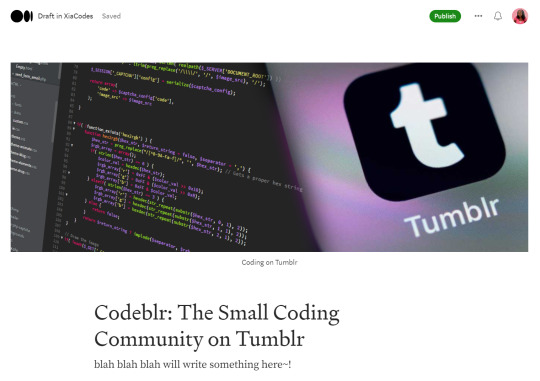
Sunday 22nd October 2023
I am making an article about us! Well, about the coding community on here (#codeblr)!
I got advice from a frequent writer on Medium that I should write about something I am passionate about and to find out what exactly, she said "What topic would you talk about for hours in front of an audience?" and honestly it would be Tumblr, but more especially about the Codeblr community!
⬇️ Below for more information + how you can help! ⬇️

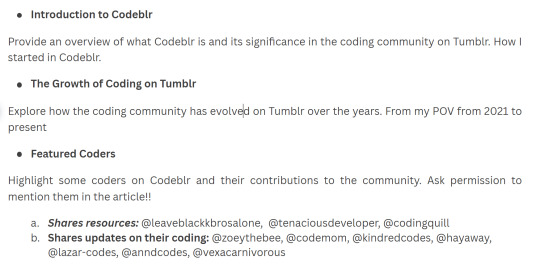
I've made some notes on what I want to talk about. It's still not complete as I made the notes around midnight last night so I was a bit tired whilst I was typing but I will take time to talk to people, plan the various topics I want to cover properly and get enough information!
🤔 What's my aim with writing the article?
To shed light to the community and the hard work everyone has put into their codeblr/studyblr blogs. From people sharing resources, to those who share their programming progresses. Someone asked me time ago about sharing their codeblr blogs on their resume/CV and on other social media platforms - if people can share their YouTube, Twitter, Instagram account on coding, why not their Codeblr blog? Your Tumblr blog is just as worthy as someone sharing on Twitter. Plus it's nicer and more welcoming here~!
Anyhoo, if you see your name in the list, I will ask permission to mention you! I won't force it or anything.
🔍 Questions for those who want to be involved!
I would greatly ask if anyone wants to be in the article, I would love to ask you about your own experience. I try my best to follow as many codeblr blogs as I can (because I love seeing that kind of posts on my feed). The questions if you want to answer (not all if you don't want to):
Why did you choose to share on Tumblr rather than the other more popular social media platforms?
Do you prefer it/Why do you like the Codeblr community?
How long have you been a member of Codeblr, and how active are you in the community?
In what ways has Codeblr contributed to your learning and growth as a coder?
Are there specific resources, tutorials, or discussions on Codeblr that have been especially beneficial to you?
Have you participated in any notable collaborations or group projects with other Codeblr members?
How do you view the importance of diversity and inclusion within Codeblr?
Have you observed efforts within the community to foster an inclusive environment?
✨ Thank you so so so much for reading, if you can't help then that's a-okay! Watch out for the article being posted on my Medium account - I'll make a new post on here when I do publish it! Fingers-crossed it's an actual good read~!

⤷ ♡ my shop ○ my mini website ○ pinned ○ navigation ♡
#codeblr#coding#progblr#programming#studyblr#studying#computer science#tech#comp sci#programmer#singal boost#signal#medium writing#articles
134 notes
·
View notes
Text
Greenbelt Maryland. Or, how America almost solved housing only to abandon it.

**I AM NOT AN EXPERT! I AM JUST AN ENTHUSIST! DO NOT TREAT MY OPINIONS/SPECULATION AS EDUCATION!**
During the Depression America faced a housing crisis that rhymes with but differs from our own. It’s different in that there wasn’t a supply issue, there were loads of houses in very desirable areas, but they were still unaffordable as people’s incomes collapsed causing a deflationary spiral. While the housing supply subtly grew and succeeded demand, people simply couldn’t pay the meager rents and mortgages. Herbert Hoover failed to manage the Depression, while his inaction is greatly exaggerated, his policy of boosting the economy with works projects and protecting banks from runs failed and the depression only got more pronounced in his term. In comes Franklin Roosevelt, a progressive liberal much like his distant and popular cousin/uncle-in-law Teddy. Franklin’s plan was to create a large safety net for people to be able to be economically viable even if they’re otherwise poor. These reforms are called the New Deal and they did many controversial things like giving disabled and retired people welfare, giving farmers conditioned subsidies to manipulate the price of food, a works program to build/rebuild vital infrastructure, etc. One of these programs was the USHA (a predecessor of America’s HUD), an agency created to build and maintain public housing projects with the goal of creating neighborhoods with artificially affordable rents so people who work low-wage jobs or rely on welfare can be housed.
In this spirit, the agency started experimenting with new and hopefully efficient housing blueprints and layouts. If you ever see very large apartment towers or antiquated brick low-rise townhouses in America, they might be these. The USHA bought land in many large and medium-sized cities to build “house-in-park” style apartments, which is what they sound like. Putting apartment buildings inside green spaces so residents can be surrounded by greenery and ideally peacefully coexist. Three entire towns were built with these ideas outside three medium-sized cities that were hit hard by the depression; Greenbelt outside DC, Greenhills outside Cincinnati, and Greendale outside Milwaukee. The idea was to move people out of these crowded cities into these more sustainable and idyllic towns. There were many catches though, the USHA planned for these towns to be all-white, they used to inspect the houses for cleanliness, they required residents to be employed or on Social Security (which basically meant retired or disabled), they also had an income limit and if your income exceeded that limit you were given a two-month eviction notice, and you were expected to attend town meetings at least monthly. While the towns didn’t have religious requirements they did only build protestant churches. Which is an example of discrimination by omission. While a Catholic, Jew, Muslim, etc could in theory move into town they also couldn’t go to a Catholic church, synagogue, or Islamic center without having to extensively travel. Things planned communities leave out might indicate what kind of people planned communities want to leave out. Basically, the whole thing was an experiment in moving Americans into small direct-democracy suburbs as opposed to the then-current system of crowded cities and isolated farm/mine towns. This type of design wasn’t without precedent, there were famously company towns like Gary and Pullman which both existed outside Chicago. But those lacked the autonomy and democracy some USHA apparatchiks desired.
The green cities were a series of low-rise apartments housing over a hundred people each, they were short walks from a parking lot and roads, and walking paths directly and conveniently led residents to the town center which had amenities and a shopping district. Greenbelt in particular is famous for its art deco shopping complex, basically an early mall where business owners would open stores for the townspeople. These businesses were stuck being small, given the income requirements, but it was encouraged for locals to open a business to prove their entrepreneurial spirit. Because city affairs were elected at town meetings the city was able to pull resources to eventually build their own amenities the USHA didn’t originally plan for like a public swimming pool or better negotiated garbage collection.
These three cities were regarded as a success by the USHA until World War II happened and suddenly they showed flaws given the shift in focus. These towns housed poor people who barely if at all could afford a car, so semi-isolated towns outside the city became redundant and pointless. The USHA also had to keep raising the income requirement since the war saw a spike in well-paying jobs which made the town unsustainable otherwise. During the war and subsequent welfare programs to help veterans, these green cities became de facto retirement and single-mother communities for a few years as most able-bodied men were drafted or volunteered. Eventually, the USDA would make the towns independent, after the war they raised the income limit yet again and slowly the towns repopulated. As cars became more common and suburbanization became a wider trend these towns would be less noticeably burdensome and were eventually interpreted as just three out of hundreds of small suburban towns that grew out of major cities. They were still all-white and the town maintained cleanliness requirements; after all they lived in apartments it just takes one guy’s stink-ass clogged toilet to ruin everyone’s day.
By the 1950’s these towns were fully independent. Greendale and Greenhills voted to privatize their homes and get rid of the income limit all together so the towns can become more normal. Greenhills, Ohio still has many of these USHA-era houses and apartments, all owned by a series of corporations and private owners. Greendale, Wisconsin property owners have demolished most of these old houses and restructured their town government so most traces of its founding are lost. But Greenbelt, Maryland still maintains a lot of its structure to this day. Greenbelt has privatized some land and buildings, but most of the original USHA apartments are owned by the Greenbelt Homes, Inc cooperative which gives residents co-ownership of the building they live in and their payments mostly go to maintenance. Because Greenbelt was collectively owned the House Un-American Activities Committee would blacklist and put on trial most of Greenbelt’s residents and officials. Though they didn’t find much evidence of communist influence, the town was a target of the red scare by the DMV area, residents were discriminated, blacklisted, and pressured into selling their assets. While Greenbelt did commodify some of the town, the still existing co-ownership shows the town’s democratic initiative to maintain its heritage. The green cities desegregated in the 50’s and 60’s depending on state law, Greenbelt was the last to desegregate under the Civil Rights Act of 1964, while discrimination persisted for years by the 1980’s the town would become half non-white, today the town is 47% black and 10% Asian.
Though these towns largely integrated with a privatized and suburbanized America, they do stand as a memorial to an idea of American urbanism that died. They were designed for walkability and were planned to be more democratic and egalitarian towns, with the conditions that came with segregation and government oversight. You can’t ignore the strict standards and racism in their history, but you can say that about many towns. How do you think America would be different if more cities had green suburbs that were more interconnected and designed for community gatherings?
#urbanism#DC#maryland#dmv#Cinncinatti#milwaukee#ohio#wisconsin#New Deal#history#fdr#franklin roosevelt#politics#urban#city#apartment#housing#great depression#article#co op#socialism#segregation#discrimination#housing crisis#landlords#united states
225 notes
·
View notes
Note
I want to start running...any tips?
I WAS BORN TO ANSWER THIS QUESTION. Thank you so much for asking! Unfortunately, I am a nerd about my hobbies so this got quite long.
Keep it simple ✨
Running is easy to get into; our bodies are built for it. Don’t stress over technicalities and just do what feels natural to you. My local races are full of 70-something white-haired pensioners who are kicking ass at it. Don’t let anyone tell you that running is meant to feel like dying, that’ll harm your knees, or that you absolutely need to have that specific smartwatch model to get into it. All you need is a solid pair of shoes, everything else is optional.
Medium effort is the way to go
The ideal aerobic running pace is a speed at which you’re able to hold a conversation, even if a bit winded. NO faster. If you’re able to sing along to your playlist or chat with a friend, that’s your ideal running pace. If you’re gasping or wheezing, slow down! You’ll get a bit faster as your lung capacity gets better, but that shouldn’t be a priority unless you want to train for a race. You get most of the health benefits of running just by keeping up a steady, sustainable, conversational pace.
Walking breaks are fine, actually
That’s the reason why I don’t love C25K as a beginner program — the way it’s structured sort of implies that walking breaks are something you should grow out of to become a more experienced runner. If you need to walk for a bit, go ahead.
If possible, jogging is preferable, just because the mechanics of even a glacial-pace jog are more similar to running than those of a faster power walk, so you might try switching to a jog after a bit of a walking interval. But walking is not a failure; there are serious marathon training plans out there that use walk/run intervals as a viable strategy.
(Related: picking up speed helps you keep going! If you feel like you are completely drained, try speeding up for a very short interval, then slowing back down. It’ll often give you an energy boost to keep going)
Run for time, not distance ⌚
Especially for beginners, I find that getting fixated on numbers can be counter productive, and the most important thing is to listen to your body. If you’re aiming to hit a certain mileage, you might get the urge to speed up at the end to get done faster. Instead, set yourself time-based goals and end every run with a cool down jog or walk.
SHOES!! 👟
Good running shoes are essential, and pretty much the only fitness-related purchase on which I’ll always support dropping money. If you get to the point where you’re consistently running 10 km (6 miles) each week, you’ll want to go to a running store — the kind of place where you’ll get fitted, and they’ll have you try on models and jog on a treadmill to evaluate your gait and let you know which characteristics your ideal shoe needs. I can’t stress enough how useful running store staff can be. They’re all running club nerds who LOVE getting new people into running, and they really want to help you find your ideal fit. Also get good running socks while you’re at it.
Be prepared to drop at least 100€ (or equivalent currency) but they usually have a great return policy if the model isn’t a good fit for you. Take care of your running shoes — maintenance, wearing them only for running, gentle cleansing etc — and the cushioning will last for quite a while (600km / 370miles at least). If you decide that you hate running, they’re still great for walking around. Once you find your ideal shoe model, it gets a lot easier to shop for it during end-of-season sales, or looking for online bargains etc. I love stocking on end-of-series shoes and rotating them so they’ll last even longer, and I buy online quite often! Just make sure your FIRST pair is fitted, for ideal injury prevention and joint health.
Injury prevention 💪
I’d love to still be running 10k races when I’m 70, but it takes some care to get there. When you run, you’re slamming your body weight up and down with every stride, and that might be hard on your joints if you’re not used to it. If you’re completely new to running, cap your runs at 15/20 minutes every other day. Do that even if you feel like you could keep going! If you have a good aerobic base already, you need to give your joints time to catch up with you lung capacity, and give your body time to recover. Do bodyweight exercises like lunges and planks and glute bridges to strengthen your core, legs, and hips. Dynamic stretches are great for warmups, and static stretches are better for cooling down. If you have the option, running on softer surface like grass or dirt is better than asphalt, which is better than concrete and pavements.
(If nothing of what I’ve said here makes sense to you, shoot me another ask, or look at some of the resources I’ve linked down below!)
Don't get bored! 🎶
I love running in groups. Running clubs are great. You can learn so much in a hands-on way from seriously experienced people, you can chat about gossip over a running job, and you can make some interesting friends. If you don’t have access to a running community, then personally I love just chilling on a run by myself listening to an audiobook or podcast or exploring a certain area.
Running form❓
Don’t stress about it. Just go out and move your body. Attempting to modify your ‘running form’ too quickly can do more harm than good. There ARE a few things you could pay attention to — I recommend trying to focus on one of these at a time for a minute or so, and alternate between them. After a while, it’ll start to feel natural to keep track of all of them:
1. Don’t slouch! But a slight lean forward is great.
2. Keep your shoulders pulled down and your upper back tense.
3. Swinging your arms in a way that helps with your stride is good, but I shouldn’t feel forced.
4. Even breaths, inhaling through your mouth and expiring through your nose.
5. Take turns to check with every part of your body, and relax them in turn: are your jaw and neck too tense? Are your fists tight?
6. Don’t overstride! shorter strides with quicker leg turnover are better than huge strides that feel awkward to you.
7. Use your glutes to drive up the motion of your legs, not just your quads. This can take a while to get used to, but it’s a game-changer.
8. ENGAGE YOUR CORE. This is a great skill to develop whether you work out or are just existing in the world — basically, let your inner abdominal muscles help you carry your weight forward. This is VERY intuitive once you know how to do it, but it’s hard to get a grasp of it if you don’t know what it means, so here are some resources about it.
an extremely fucking comprehensive article that improved my life and eased my big-boobs back pain
similar content but in video form
a running-specific form video
Personally, learning to do this made me feel like I unlocked a superpower. Go forth and brace.
Accessories and tips 🤓
Like I said above, the only thing I really suggest spending money on for real is running shoes. Everything else is details! However, I’m nothing if not wordy I have Thoughts about those details, too.
Run tracking: I suggest downloading Runkeeper if you want to keep track of your runs — it’s free, intuitive, and solid! If you decide to get into wearables, a low-level Garmin >>>>> anything else.
Self-care: use sunscreen and/or thick face cream as needed. Stop to sip at a public fountain if needed. Get a small fanny pack to hold your phone, keys, or lip balm if needed. If chafing is an issue, anti-glide gel is relatively affordable.
Outfits etc: I get all my running gear and clothes from Decathlon — they are in most countries and ship worldwide. I especially love this thermal shirt for colder weather
Safety: if you’re running on the road, make sure to run in the opposite direction from traffic and to wear something bright. If you run with headphones near traffic, keep the volume down, or get over-the-ear conductor headsets. I love shokz, they're fantastic.
Post-run snack: eating something small and carb-heavy within 30 mins of a workout is great for kickstarting recovery. I love dried fruit personally.
Various resources 📝
Routine basics: check out the r/running order of operations, which is a great “how to” guide to building a basic running routine. I also recommend that subreddit's wiki! Running programming gets exponentially more involved the more advanced you get, etc — if you ever have any questions, hit me up!
Dynamic stretching warmup: a quick leg swing workout to get your legs ready to go. If you’re feeling overachieving, here’s a lunge warmup routine and a how-to bodyweight squat video.
Cooldown routine! Check out Strength and Mobility, a great post-run quick cooldown routine that includes some bodyweight exercises to strengthen your hips and core. Video included.
that's all, folks! 🏃♀️
Sorry I got carried away! I love running. I love getting people into running. My mental health, cardiovascular system and my popping quads also love running. But FYI, some people hate running and that's also fine! If you decide it’s not for you, find something you like more. There are a lot of misconceptions out there and a lot of guilt-tripping and body shame-y rhetoric around exercising, especially aimed at women, and I want to make clear it’s all bullshit. Just have fun <3
#Anonymous#ask#jockposting#running#fitblr#exercise tips#running basics#exercise#runblr#long post#for reference I mostly run in brooks ghosts but I use the levitate for speedwork and more intense long runs#I stock whenever there's a sale on runnea or runningwarehouse or whatever#pinned
997 notes
·
View notes
Text
So-called motorcylists love to shove their beloved bikes away whenever there's a little bit of snow on the road. That's because motorcyclists are famously concerned with their public perception. They don't want to drive around town with wood screws run through their tires, shrieking profanities at stopped traffic before ripping a perfect 12 'o' clocker and driving across the iced-over multi-use-pathway, comfortable in their knowledge that the police will not and can not follow. Or it's because they don't have heated grips, and their handsies get cold.
Heated steering wheels are the single greatest innovation in cars in the last two hundred years. Unfortunately for me, they hadn't been installed into cars of the age I own. In the late 1970s, the newest innovation in steering wheel comfort was "maybe make them a little smaller, for the ladies." Seems like I was cursed to a lifetime of wondering if my thermostat was seized, freezing to death even through many layers of mittens and work gloves while waiting for the tow truck to arrive and clean up the commuters in front of me.
Of course, Plymouth also didn't equip this car with a lot of other modern features. For instance, liquid-cooled active speed laser and radar jamming was not available. Active pursuit drones pre-programmed with a seek-and-destroy order for all speed cameras were not yet on the market, unless you worked for the CIA. And also the good people of China had not figured out how to make $35 45-millimetre ball-bearing turbochargers capable of adding nearly four hundred horsepower to any engine strong enough to keep its guts on the inside when presented with one medium-sized jet engine's worth of boost. I had to add all those things myself.
Easy, right? Run some wires to a heating element on the steering wheel. There's just one complication: steering wheels turn. If I keep spinning the car left and right, eventually the wire will get tangled up and rip itself out, causing an electrical fire. Admittedly, that will also keep my hands warm, but the walk home after is inconvenient.
The original "engineers" who took a whisky-soaked gander at this car before slapping their secretaries on the ass had a solution, though. In every steering wheel, the horn button has the same problem. Unfortunately for me, the horn hasn't worked in this car since 1983, which complicated my attempts to reuse the wiring.
Ultimately, I came up with what a rocket scientist would call "a compromise." A pair of bolt cutters and a map to the local truck-supply warehouse's storage yard soon provided me with a nifty diesel-fired interior heater, a roaring flame that consumes all and produces enough heat to make toast from three feet away. Ratchet-strapped to the place where the passenger seat used to be, it will keep my fingers warm, as well as my feet and every other part of my body. Sure, it's inconvenient having to continually refill it with stolen farm diesel, and I could have run the exhaust pipe out of the cabin a better way than through the rust hole in the floor. Once you get that heated seat feeling, though, you simply can't go back. If you'll excuse me, I need to get going: if I don't get to work in the next five minutes, my boots will melt again.
158 notes
·
View notes
Text
Decarbonization initiatives aim to prepare Brazilian industry for climate crisis
FIESP, SEBRAE-SP, and SENAI-SP offer consulting services to help reduce greenhouse gas emissions

Seeking to boost the competitiveness of small and medium-sized Brazilian industries while addressing environmental challenges posed by climate change, the São Paulo State Federation of Industries (FIESP), in partnership with SENAI-SP and SEBRAE-SP, has launched a new round of “decarbonization initiatives” across the state this month.
The program targets companies with annual revenues of up to R$8 million, offering consulting services focused on reducing greenhouse gas emissions. Participants receive training and gain access to a platform for tracking emissions inventories.
“This initiative is about sharing knowledge to enhance our industrial ecosystem, reducing fossil fuel consumption and reliance on non-renewable energy sources,” said Paulo Schoueri, director of FIESP’s interunion development department and the federation’s vice president. “By improving these processes, industrial companies can produce more efficiently and sustainably.”
Mr. Schoueri emphasized that the success of Brazil’s industrial sector in the 21st century depends on businesses of all sizes adopting sustainable production methods. He noted that modernizing production processes is not just an environmental necessity but also an economic imperative.
Continue reading.
#brazil#brazilian politics#politics#economy#environmentalism#image description in alt#mod nise da silveira
7 notes
·
View notes
Text
Noel Deyzel and His Rise on TikTok

Noel Deyzel and His Rise on TikTok
Introduction
Noel Deyzel has become a household name in the fitness community, thanks to his remarkable presence on TikTok. Known for his motivational content, fitness tips, and engaging personality, Noel has inspired millions worldwide. This article delves into his rise on TikTok, exploring how he leveraged the platform to become a fitness icon.
Early Life and Background
Noel Deyzel’s journey began long before he ever heard of TikTok. Born and raised in South Africa, Noel had a passion for sports and fitness from a young age. Initially pursuing a career in business, he soon realized his true calling lay in bodybuilding and fitness coaching. This transition marked the beginning of a new chapter in his life, one that would eventually lead him to TikTok fame.
Discovery of TikTok
In the early days of TikTok, Noel saw an opportunity to reach a broader audience. Unlike other social media platforms, TikTok’s algorithm favored short, engaging videos, making it the perfect medium for his fitness tips and motivational speeches. Noel started by observing popular trends and understanding what type of content resonated with users.
Content Strategy and Growth
Noel’s content is a mix of fitness advice, workout routines, motivational speeches, and personal anecdotes. By participating in trends and challenges, he kept his content relevant and engaging. Collaborations with other TikTok influencers also played a crucial role in his growth. His commitment to posting regularly and maintaining high-quality content helped him build a loyal following.
Engagement with Followers
One of Noel’s strengths is his genuine interaction with his followers. He responds to comments, engages in duets, and often addresses fan questions in his videos. This level of interaction has fostered a sense of community, making his followers feel valued and appreciated.
Viral Videos and Breakthrough Moments
Noel’s rise to fame includes several key viral moments. Videos where he shared his personal fitness journey, transformation stories, and motivational messages resonated deeply with viewers. These viral videos significantly boosted his follower count and solidified his position as a fitness influencer.
Fitness Tips and Inspirational Content
Noel’s approach to fitness content is practical and motivational. He offers actionable fitness tips, from workout routines to diet advice, ensuring his followers have the tools they need to succeed. Additionally, his inspirational content, which often includes personal stories of overcoming obstacles, helps motivate his audience to pursue their own fitness goals.
Personal Branding and Merchandise
As his popularity grew, Noel developed a strong personal brand. He launched fitness programs, branded merchandise, and even an app to help his followers stay on track with their fitness journeys. This diversification not only enhanced his brand but also provided additional revenue streams.
Challenges Faced and Overcome
Noel’s journey to TikTok fame wasn’t without challenges. Initially, he struggled with gaining traction and faced criticism from skeptics. However, his resilience and dedication helped him overcome these obstacles. He also had to balance his personal life with the demands of creating content, a challenge many influencers face.
Impact on the Fitness Community
Noel has had a significant impact on the fitness community. His no-nonsense advice and motivational content have inspired many to take up fitness seriously. He has also helped demystify bodybuilding, making it more accessible to a broader audience.
Collaborations and Partnerships
Collaborations with other TikTok influencers and brand partnerships have been pivotal in Noel’s journey. By partnering with like-minded creators, he expanded his reach and introduced his content to new audiences. Sponsorship deals with fitness brands have also helped him monetize his TikTok presence.
Transition to Other Platforms
Recognizing the importance of diversifying his online presence, Noel expanded to Instagram, YouTube, and other platforms. This move allowed him to reach different demographics and share more detailed content, such as long-form workout videos and vlogs.
Future Plans and Aspirations
Looking ahead, Noel has big plans. He aims to continue growing his brand, launching new fitness products, and expanding his reach globally. His vision includes not only inspiring people through social media but also creating tangible resources to help them achieve their fitness goals.
Conclusion
Noel Deyzel’s rise on TikTok is a testament to the power of authentic content and genuine engagement. His journey from a fitness enthusiast to a social media icon is inspiring, demonstrating that with dedication and a clear vision, anything is possible. As he continues to evolve, there’s no doubt that Noel will keep motivating and inspiring millions around the world.
FAQs
How did Noel Deyzel become famous on TikTok?
Noel became famous on TikTok by sharing engaging fitness tips, motivational content, and personal stories. His consistent posting and genuine interaction with followers helped him build a large and loyal audience.
What kind of content does Noel Deyzel create?
Noel creates a variety of content, including fitness advice, workout routines, motivational speeches, and personal anecdotes. He also participates in TikTok trends and challenges.
How does Noel Deyzel interact with his followers?
Noel interacts with his followers by responding to comments, engaging in duets, and addressing fan questions in his videos. This engagement has helped him build a supportive community.
What challenges has Noel Deyzel faced on his journey?
Noel has faced challenges such as gaining initial traction on TikTok, handling criticism, and balancing personal life with content creation demands. His resilience and dedication helped him overcome these obstacles.
What are Noel Deyzel’s future plans?
Noel plans to continue growing his brand, launching new fitness products, and expanding his global reach. He aims to inspire more people through social media and provide tangible resources for achieving fitness goals.
19 notes
·
View notes
Text


It took me a minute to finally get my notes straight so I could answer this— I hope it was worth the wait! I’ll give some bullet points of tips I use to help boost my production speed in addition to the strategies I use to try to keep characters consistent. Let’s get into it!

First up: How I draw faster!
Note that these mostly apply to digital art, as that’s my preferred medium.
If your art program has them, experiment with brush stabilization levels. My hands shake really bad, especially while I’m drawing, so I put a lot of effort into finding a stabilizer level that works with my need to control lines while also smoothing out the tremors in my hands. It’s made it so much easier to draw lines like I want to, and therefore lets me move on instead of redrawing the same line over and over again.
Creating templates for your art helps so much— setting up things like canvas size, color profile, DPI, background colors and images like the paper texture PNGs that I love to use ahead of time helps me get drawing faster, while I’m excited and inspired! Similarly, having a naming system for your art files is useful for speed as well as finding and organizing old pieces easier.
Having premade color palettes of local colors for characters is also super helpful for speed, as well as keeping characters on model :>
Personally, I use a single brush for lineart and rely on the selection tool and bucket fill for coloring when I actually bother to color things in. My lines are pretty loose nowadays, and the same goes for when I color things— I don't abide exactly by the lineart I draw, and get pretty messy with the selection tool and bucket fill!
I simplify character designs as much as possible— the standard design of a sigilyph, for example, is pretty complex. But I made Sen a lot simpler (and also forgot the spikes on her torso in this panel. Oops)
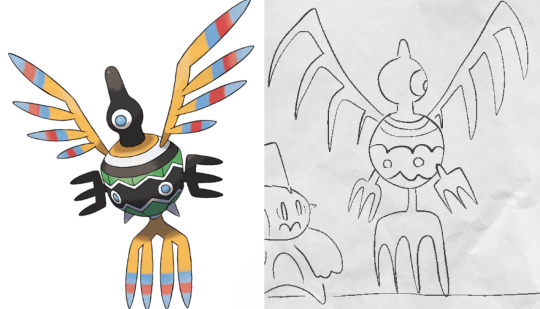
As for keeping characters on-model…
I’m very flattered that you feel otherwise, but I actually don't keep characters very on-model between different drawings— just look at the different ways I've drawn Ark below— however, I'm improving over time as I become more familiar with how I want to draw the characters! A big part of my process of keeping characters on model is drawing characters over and over to familiarize myself with how they should look through trial and error.

Learning common angles and poses I will draw characters in is very helpful for making sure they look consistent. As a bit of a downside, though, it makes wonkier angles stick out like a sore thumb! Drawing Ark with his head slightly angled downward was really hard, and I don't think I communicated it that well here:

I try to have the characters broken down into as many simple shapes that fit into each other as I possibly can, like Twig’s head (circle + rectangle snout + angled rectangle horn) Ark's hair (that weird bangs shape) and Dusknoir's upper body (beanbag shape / slightly elongated circle torso, arms coming out of his frill that comes in a very particular arcing line). This makes it way easier to draw characters quickly and consistently, because I can learn those lines and shapes and get the motion of drawing them into muscle memory.

Also, knowing the ways characters emote is like knowing cheat codes. Giving characters things like a signature comedic expression of shock or grin that they make when they're happy are very helpful!

The biggest tip I can give on the topic of keeping characters on-model (at least without model sheets— model sheets are THE way to go. Don’t be like Sofie and neglect those pieces of gold) is really just to practice. Build up familiarity with the shapes and proportions of characters, get a feel for how your hand and wrist moves to get the lines right.

#creativity tips with sofie#art tips#drawing tips#drawing advice#art advice#stuff by sofie#sofie answers asks#(kinda)
21 notes
·
View notes
Text
Greenbelt Maryland. Or, how America almost solved housing only to abandon it.
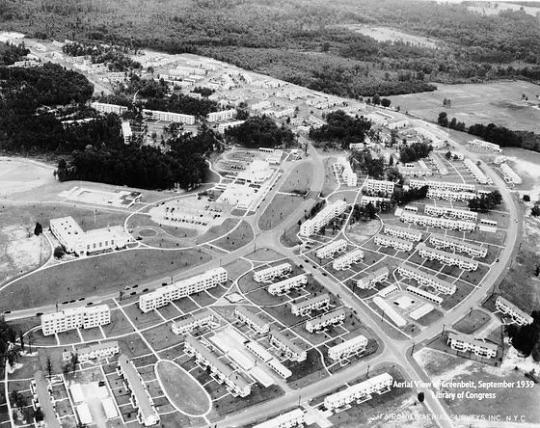
**I AM NOT AN EXPERT! I AM JUST AN ENTHUSIST! DO NOT TREAT MY OPINIONS/SPECULATION AS EDUCATION!**
During the Depression America faced a housing crisis that rhymes with but differs from our own. It’s different in that there wasn’t a supply issue, there were loads of houses in very desirable areas, but they were still unaffordable as people’s incomes collapsed causing a deflationary spiral. While the housing supply subtly grew and succeeded demand, people simply couldn’t pay the meager rents and mortgages. Herbert Hoover failed to manage the Depression, while his inaction is greatly exaggerated, his policy of boosting the economy with works projects and protecting banks from runs failed and the depression only got more pronounced in his term. In comes Franklin Roosevelt, a progressive liberal much like his distant and popular cousin/uncle-in-law Teddy. Franklin’s plan was to create a large safety net for people to be able to be economically viable even if they’re otherwise poor. These reforms are called the New Deal and they did many controversial things like giving disabled and retired people welfare, giving farmers conditioned subsidies to manipulate the price of food, a works program to build/rebuild vital infrastructure, etc. One of these programs was the USHA (a predecessor of America’s HUD), an agency created to build and maintain public housing projects with the goal of creating neighborhoods with artificially affordable rents so people who work low-wage jobs or rely on welfare can be housed.
In this spirit, the agency started experimenting with new and hopefully efficient housing blueprints and layouts. If you ever see very large apartment towers or antiquated brick low-rise townhouses in America, they might be these. The USHA bought land in many large and medium-sized cities to build “house-in-park” style apartments, which is what they sound like. Putting apartment buildings inside green spaces so residents can be surrounded by greenery and ideally peacefully coexist. Three entire towns were built with these ideas outside three medium-sized cities that were hit hard by the depression; Greenbelt outside DC, Greenhills outside Cincinnati, and Greendale outside Milwaukee. The idea was to move people out of these crowded cities into these more sustainable and idyllic towns. There were many catches though, the USHA planned for these towns to be all-white, they used to inspect the houses for cleanliness, they required residents to be employed or on Social Security (which basically meant retired or disabled), they also had an income limit and if your income exceeded that limit you were given a two-month eviction notice, and you were expected to attend town meetings at least monthly. While the towns didn’t have religious requirements they did only build protestant churches. Which is an example of discrimination by omission. While a Catholic, Jew, Muslim, etc could in theory move into town they also couldn’t go to a Catholic church, synagogue, or Islamic center without having to extensively travel. Things planned communities leave out might indicate what kind of people planned communities want to leave out. Basically, the whole thing was an experiment in moving Americans into small direct-democracy suburbs as opposed to the then-current system of crowded cities and isolated farm/mine towns. This type of design wasn’t without precedent, there were famously company towns like Gary and Pullman which both existed outside Chicago. But those lacked the autonomy and democracy some USHA apparatchiks desired.
The green cities were a series of low-rise apartments housing over a hundred people each, they were short walks from a parking lot and roads, and walking paths directly and conveniently led residents to the town center which had amenities and a shopping district. Greenbelt in particular is famous for its art deco shopping complex, basically an early mall where business owners would open stores for the townspeople. These businesses were stuck being small, given the income requirements, but it was encouraged for locals to open a business to prove their entrepreneurial spirit. Because city affairs were elected at town meetings the city was able to pull resources to eventually build their own amenities the USHA didn’t originally plan for like a public swimming pool or better negotiated garbage collection.
These three cities were regarded as a success by the USHA until World War II happened and suddenly they showed flaws given the shift in focus. These towns housed poor people who barely if at all could afford a car, so semi-isolated towns outside the city became redundant and pointless. The USHA also had to keep raising the income requirement since the war saw a spike in well-paying jobs which made the town unsustainable otherwise. During the war and subsequent welfare programs to help veterans, these green cities became de facto retirement and single-mother communities for a few years as most able-bodied men were drafted or volunteered. Eventually, the USDA would make the towns independent, after the war they raised the income limit yet again and slowly the towns repopulated. As cars became more common and suburbanization became a wider trend these towns would be less noticeably burdensome and were eventually interpreted as just three out of hundreds of small suburban towns that grew out of major cities. They were still all-white and the town maintained cleanliness requirements; after all they lived in apartments it just takes one guy’s stink-ass clogged toilet to ruin everyone’s day.
By the 1950’s these towns were fully independent. Greendale and Greenhills voted to privatize their homes and get rid of the income limit all together so the towns can become more normal. Greenhills, Ohio still has many of these USHA-era houses and apartments, all owned by a series of corporations and private owners. Greendale, Wisconsin property owners have demolished most of these old houses and restructured their town government so most traces of its founding are lost. But Greenbelt, Maryland still maintains a lot of its structure to this day. Greenbelt has privatized some land and buildings, but most of the original USHA apartments are owned by the Greenbelt Homes, Inc cooperative which gives residents co-ownership of the building they live in and their payments mostly go to maintenance. Because Greenbelt was collectively owned the House Un-American Activities Committee would blacklist and put on trial most of Greenbelt’s residents and officials. Though they didn’t find much evidence of communist influence, the town was a target of the red scare by the DMV area, residents were discriminated, blacklisted, and pressured into selling their assets. While Greenbelt did commodify some of the town, the still existing co-ownership shows the town’s democratic initiative to maintain its heritage. The green cities desegregated in the 50’s and 60’s depending on state law, Greenbelt was the last to desegregate under the Civil Rights Act of 1964, while discrimination persisted for years by the 1980’s the town would become half non-white, today the town is 47% black and 10% Asian.
Though these towns largely integrated with a privatized and suburbanized America, they do stand as a memorial to an idea of American urbanism that died. They were designed for walkability and were planned to be more democratic and egalitarian towns, with the conditions that came with segregation and government oversight. You can’t ignore the strict standards and racism in their history, but you can say that about many towns. How do you think America would be different if more cities had green suburbs that were more interconnected and designed for community gatherings?
#urbanism#DC#maryland#dmv#Cincinnati#milwaukee#ohio#wisconsin#New deal#history#fdr#franklin roosevelt#politics#urban#city#apartment#housing#great depression#article#co op#socialism#segregation#discrimination#housing crisis#landlords#united states
7 notes
·
View notes
Text

Reasons behind the fast economic growth of Saudi Arabia:
The rapid economic growth of Saudi Arabia in 2022, especially being the fastest-growing among G20 economies, can be attributed to several key factors:
- Increased Oil Production and Prices: Saudi Arabia, being one of the world's largest oil producers, benefited significantly from rising global oil prices and increased production levels. The rebound in global demand for oil post-pandemic, combined with geopolitical tensions that disrupted other oil supplies, contributed to higher revenues.
- Economic Reforms Under Vision 2030: The Saudi government’s Vision 2030 initiative aims to diversify the economy away from oil dependency. Reforms under this vision have encouraged growth in non-oil sectors such as tourism, entertainment, real estate, and finance, driving economic expansion.
- Investment in Infrastructure: Major infrastructure projects, including NEOM, the Red Sea Project, and the expansion of Riyadh, have attracted significant investments. These projects are not only boosting construction and related industries but are also creating jobs and stimulating the overall economy.
- Foreign Direct Investment (FDI): Saudi Arabia has seen an increase in FDI due to improved business regulations, economic reforms, and strategic partnerships with global companies. The Kingdom's efforts to create a more business-friendly environment have made it an attractive destination for foreign investors.
- Strong Private Sector Growth: Government initiatives to boost the private sector, including supporting small and medium enterprises (SMEs), have contributed to economic growth. Privatization of certain sectors and public-private partnerships have also played a role.
- Expansion of Non-Oil Sectors: Sectors such as tourism, entertainment, and technology have seen rapid growth, fueled by government support and increased consumer spending. Events like the Saudi Seasons, international sporting events, and cultural festivals have attracted visitors and investments.
- Labor Market Reforms: Reforms in the labor market, including Saudization efforts (Nitaqat program) and improved labor laws, have increased workforce participation and productivity, particularly among women and young Saudis.
- Fiscal Prudence and Debt Management: Saudi Arabia has implemented effective fiscal policies, including managing public debt and reducing the budget deficit, which has helped stabilize the economy and promote growth.
- Global Economic Recovery: The global economic recovery post-COVID-19 also played a role, as increased global trade and investment flows positively impacted Saudi Arabia's economy.
These factors combined to create a robust and diversified growth environment, contributing to Saudi Arabia's rapid economic expansion
#KhalidAlbeshri #خالدالبشري
#advertising#artificial intelligence#autos#business#developers & startups#edtech#education#finance#futurism#marketing
10 notes
·
View notes
Text
Do white Americans owe reperations to blacks? NO!
In America, Reparations have already been paid. To the point that it’s beyond ridiculous. Whites have gone out of their way to artificially boost Nonwhites at every turn. Trillions of tax dollars and donations have been spent over decades trying to boost non-white achievements and social status. Also dept relief, Crt, affirmative action, first step act, donations for past wrong doings, school degrees, food stamps, welfare programs, etc.
Alot of whites and some jews through out American history tried to help blacks become a separate & self-reliant people (the pursuit of Booker T. Washington) through education.
The Freedman's Bureau (1865 to 1872) :
The Freedman’s Bureau (officially known as ‘The Bureau of Refugees, Freedmen, and Abandoned Lands’) was created by Americans to feed and provide other life necessities to the Negro population of the South after the Civil War ended in 1865. However, well before the end of the Civil War, Americans organized all over the North various organizations to feed, clothe, educate and provide other needed necessities for the newly freed Negro people Note: according to W.E.B Du Bios, more than 50 organizations were active in relief capacity for the southern Negro by 1866.
"The First white people in America, certainly the first in the South to exhibit their interest in the reaching of the Negro and saving his soul through the medium of the Sunday-school were Robert E. Lee and 'Stonewall Jackson'. ...Where Robert E. Lee and 'Stonewall' Jackson have led in the redemption of the Negro through the Sunday-school, the rest of us can afford to follow. " - Booker T. Washington 1910
The Tuskegee Institute:
This icon of Black education was founded by the great Booker T Washington and was also the brainchild of an Alabama prominent banker by the name of George W. Campbell (White man). Another White man, an Alabama state senator named W.F. Foster, spearheaded the necessary funding for the Institute through the state legislature. The result was a yearly appropriation of $2000.
The following white Americans, all self-made millionaires, gave small fortunes - their own hard earned money - to this Negro self-sufficiency school over their lifetime:
--Andrew Carnegie
--John D. Rockefeller
--Henry Rodgers
--Collis Huntington
And,
--Julius Rosenwald*
--Anna T. Jeanes*
* Julius Rosenwald was an immigrant Jew and self-made millionaire.
* Anna T. Jeanes, a white woman, was not a self-made millionaire, but inherited her money from her husband.
Howard University
Howard University was chartered in 1867. It was championed by an American Civil War General, Oliver Otis Howard (November 8, 1830 – October 26, 1909), and the school hence bears his name. Howard University is also the ONLY higher education school ever to be directly funded by the US taxpayers (it still is).
Lincoln University
Lincoln University (Pennsylvania) was an exclusive college for Negroes and was created in 1854 by a white man named John Miller Dickey, who also became its first president. Lincoln University was originally named Ashmun Institute. The first Black president of the university was not elected until 1945.
Fisk University
Fisk University was an all-Negro college that was established by three whites, Erastus Milo Cravath, John Ogden and Edward Parmelee Smith in Nashville, Tennessee, in 1866.
Wilberforce University
Wilberforce University, located near Xenia, in Ohio, was an all-Negro college created by whites from the Methodist Episcopal Church in 1856. It was named after a white man, William Wilberforce, who was an 18th century abolitionist.
Cheyney University of Pennsylvania
Cheyney University of Pennsylvania was an all-Negro school established in 1837. A white man named Richard Humphreys had bequeathed $10,000 in his will (10% of his estate) in 1832 for the sole purpose of creating a place of education for the Negro race.
Atlanta University
Atlanta University was founded by whites associated with the American Missionary Association, in 1865. Around 1866, its survival then shifted to, and depended upon, the Americans associated with the Freedman’s Bureau.
In 1922, the Carnegie Corporation and the Rockefeller Memorial gave $25,000 each to create the Journal Of Negro History.
In 1924, George Eastman (Kodack Co.) gave Tuskegee Institute $1 million dollars.
John D. Rockefeller
Mr. Rockefeller donated almost $180 million dollars to the General Education Board, which was chartered by Act of Congress in 1903. Much of this money was spent supplying educational aid to the Negro people, specifically in the southern states (Mr. Rockefeller‘s $180 million translates to almost 2 billion dollars in today's dollars!)
George Peabody Education Fund for poor Southerners
George Peabody Education Fund was established by a white man named George Peabody, and was designed to help Negro colleges in the South at the turn of the century.
The Slater Fund
The Slater Fund was established by white, James Fox Slater, in 1882. Its primary purpose was to support southern Negro schools. Around 1915, this fund was worth about $1.75 million.
The Jeanes Fund (Jeanes Foundation)
A white woman named Miss Anna T. Jeanes, a Quaker, created 'The Fund for Rudimentary Schools for Southern Negroes’ in 1907 from the monies left to her by her late husband. The purpose of the fund was to help Negroes create teachers for their people. It was endowed at one million dollars (a staggering sum at the time).
The Southern Education Board: In or around 1900, whites created the The Southern Education Board. It's funding was initially provided by the Slater Fund and the Jeans Funds. Americans, trained in the area of farming, would go to rural farms (Negro and American) and educate them on better farming techniques. The Southern Education Board was also very concerned with the high southern Negro illiteracy, which was, in 1900, almost 50% (for southern Americans, around 11%).
Phelps-Stokes Fund
Established in 1911, a white philanthropist and self-made millionaire Anson Phelps Stokes created this fund for the purpose of improving Negro life through education. Its endowment was approximately $900,000.
Minor Fund
This fund was established by a white female, Miss Myrtilla Minor, in 1851. Its purpose was to provide aid to schools who would teach Negro girls to be teachers for their people.
In 1910, according to the US census, 50% of Negroes (about 4.8 million) lived in urban centers (all created by white males). That means there would be approximately 2.4 million Negro males living in the urban centers of America. About 1/3rd would be too young to work, so that means there were about 1.6 million Negro males of working age living in American-built cities in 1910. Of those 1.8 million Negro males, 350,000 (almost 20%!) worked in a factory job (all factory jobs for the Negro were supplied by White men i.e. not ONE factory job in America was created by a Negro male --so, concomitantly, no white man was employed by a Negro male in a factory job. Note: At this time in American history, you worked or you starved. (source: Chronological History of The Negro pg. 358)
Naturally, with whites, being so generous supplying jobs to black men, naturally, more black men were encouraged to come to the American-built urban areas.
Julius Rosenwald
Without question one of the most generous of the Euro race toward the black people was Julius Rosenwald (Jewish). Most of his charity was gifted through the Rosenwald Fund (depleted in 1948)
Cushing Fund
A white woman, Miss Emeline Cushing, established this fund in 1895 for the purpose of financially assisting colored schools.
Whites Create Special School - In Mississippi. - For Negro Boys To Own Land
Daniel Hand Fund
A white self-made millionaire, Daniel Hand, established the Daniel Hand Fund in 1888. It was endowed at $1 million dollars (two-thirds of Mr. Hand’s entire personal wealth!). Mr. Hand stipulated that all of the Fund would be directed toward Negro education in the former slave states. When Mr. Hand died in 1893, he bequeathed the rest of his remaining wealth to this fund.
Andrew Carnegie
Mr. Carnegie, when he retired, was considered the richest man in the world. He also became the biggest philanthropist in America and gave generously to Negro educational causes, which included giving $600,000 to the Tuskegee Institute in 1903.
Harmon Foundation
The New York City Harmon Foundation was established in 1922 by an white man named William Harmon (1862-1928). Its purpose was to aid and assist Negro art, artists, businesses, education for Negroes, farming needs, music, and other causes for the Negro.
Garland Fund
This White-male-established fund was used to help the NAACP through the Great Depression.
John D. Rockefeller Jr.
Mr. Rockefeller, Jr. built the Dunbar Apartments in New York City, a mammoth complex consisting of six buildings - 511 apartments - specifically to house low-income Negroes in Harlem. He also built and funded a bank in NYC solely for Negroes.
Katharine Drexel
Katherine Drexel was born November 26, 1858 and died March 3, 1955. She was an American female, a nun, philanthropist, educator and later canonized as a Roman Catholic saint.
"She became a nun, and took the name Sister Katharine, dedicating herself and her inheritance to the needs of [non-occupational ranking] Native Americans and African-Americans in the western and southwestern United States, and was a vocal advocate of racial tolerance. She established a religious order, the Sisters of the Blessed Sacrament for Indians and Colored People. She also financed more than 60 missions and schools around the United States, and founded Xavier University of Louisiana[1] - the only historically Black, Roman Catholic university in the United States to date."
The United Negro College Fund
In 1944 the United Negro College Fund was created. Almost all of the funding for its initial operation was provided by the General Education Fund and the Rosenwald Fund.
Mr. William Trent, a black man, in the course of his 20-year tenure as its first executive director, raised over $78 million for this fund, almost all of it coming from generous white liberal Americans (Senator John F. Kennedy gave all of the profits from his book ‘Profiles in Courage' to this fund).
Also American Jews also gave money to black people. Before 1950, it was mostly coming from the Rosenwald fund.
Minority scholarships:

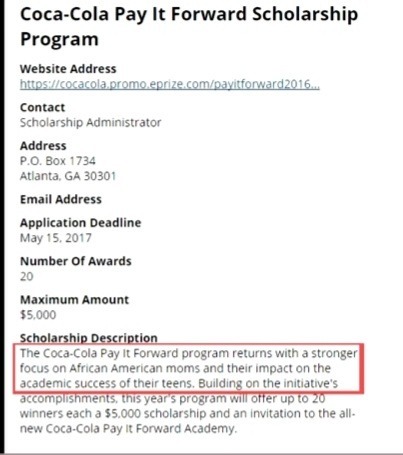
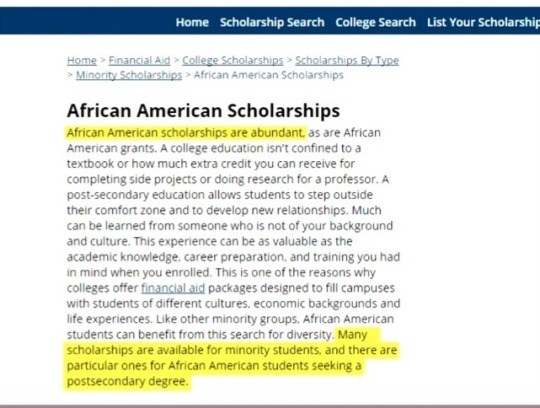
Low income:

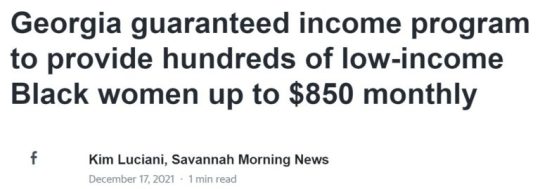

It’s open to illegal immigrants, too, but white people? Forget it. And when we learn that ���800 Compton residents to get guaranteed income in two-year pilot program,” since Compton is only 2 percent white – yes, just 2 percent – white people won’t get that money.

Having to change the requirements of mental retardation, because too many blacks IQ's were that low.
https://mn.gov/mnddc/parallels2/pdf/90s/99/99-MRI-MLW.pdf

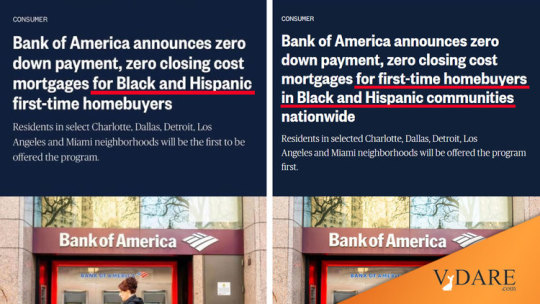
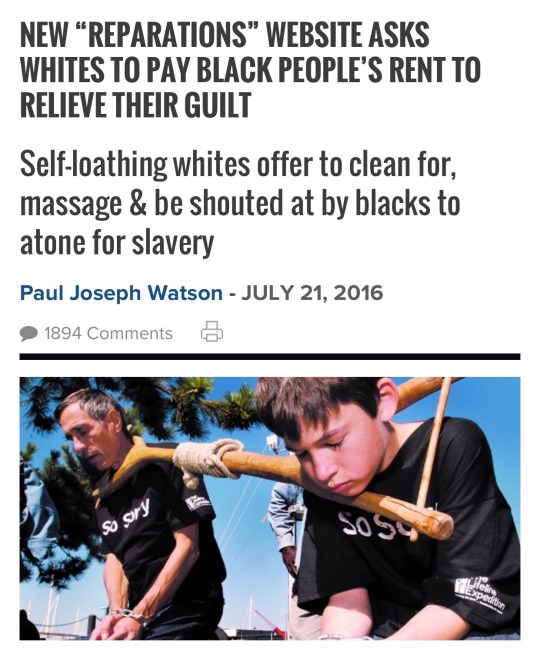
89 notes
·
View notes
Text
How to Increase the Chance of Boosting Your Stories on Medium
Comprehensive Guide for Aspiring Writers by an Experience Book Author, Editor, and Content Strategist Based on my decades of writing and editing experience, I summarized the critical success factors to increase the visibility of content on any writing platform, including Medium. Dear Fellow Writer, this is Dr Mehmet Yildiz, owner and chief editor of ILLUMINATION Integrated Publications on…
#business#Increase the chance of boosting#Medium#Self Improvement#stories#The Boost Program on Medium#writers#writing#writingcommunity
2 notes
·
View notes
Text
Thailand Privilege Visa
The Thailand Privilege Visa, widely known as the Thailand Elite Visa, is a long-term residency program designed to attract affluent individuals and families. Operated by the Thailand Privilege Card Company Limited under the Ministry of Tourism and Sports, the visa combines flexible residency options with exclusive lifestyle benefits. Its multi-tiered offerings cater to retirees, investors, businesspeople, and frequent travelers.
1. Key Features and Benefits
Residency Duration:
Options range from 5 to 20 years, depending on the selected membership package.
Visa holders are exempt from annual visa renewals.
Travel Convenience:
Unlimited multi-entry privileges and expedited immigration clearance.
Exclusive airport services, including fast-track lanes and access to VIP lounges.
Lifestyle Perks:
Complimentary golf, spa treatments, and annual health check-ups at top facilities.
Discounts at luxury hotels, restaurants, and partner establishments.
Family Inclusion:
Specific packages allow family members to share the privileges for reduced fees.
2. Membership Packages
2.1 Elite Easy Access
Duration: 5 years.
Cost: 600,000 THB.
Ideal For: Individuals seeking medium-term residency.
2.2 Elite Family Excursion
Duration: 5 years for two family members.
Cost: 800,000 THB; additional members pay 300,000 THB each.
2.3 Elite Privilege Access
Duration: 10 years.
Cost: 1 million THB.
2.4 Elite Superiority Extension
Duration: 20 years.
Cost: 1 million THB.
2.5 Elite Ultimate Privilege
Duration: 20 years.
Cost: 2.14 million THB.
Additional Perks: Enhanced concierge services and increased healthcare benefits.
3. Application Process
Eligibility:
Open to individuals of all nationalities with no criminal record.
Applicants must demonstrate financial capability to cover the membership fee.
Steps to Apply:
Submit an online application along with required documents (passport, photographs, etc.).
Pay the membership fee upon approval.
Collect the visa at a Thai embassy, consulate, or immigration office.
Processing Time:
Applications are typically processed within 1–2 months.
4. Legal Considerations
Work Restrictions:
The visa does not include a work permit; separate authorization is required for employment.
No Path to Citizenship:
The Thailand Privilege Visa does not lead to permanent residency or Thai citizenship.
Tax Residency:
Tax obligations depend on the number of days spent in Thailand. Holders staying for more than 180 days in a calendar year are considered tax residents.
5. Contribution to the Thai Economy
Tourism and Real Estate:
Visa holders often invest in high-end real estate and contribute to luxury tourism sectors.
Economic Stability:
The program attracts high-net-worth individuals, boosting domestic revenue streams.
Long-Term Development:
Supports Thailand’s strategic goals of attracting foreign investment and skilled individuals.
Conclusion
The Thailand Privilege Visa offers unparalleled access to long-term residency and exclusive services, making it an ideal choice for retirees, frequent travelers, and investors. With its flexible packages and comprehensive benefits, the program supports a luxurious and hassle-free experience in Thailand. While the visa is financially demanding, its convenience and privileges make it a worthwhile investment for eligible individuals.
#thailand#thai#visa#thaivisa#privilegevisa#thaiprivilegevisa#thailandprivilegevisa#privilegevisainthailand#immigration#immigrationlaw#immigrationinthailand#thaiimmigration#immigrationlawyers#immigrationlawyersinthailand
2 notes
·
View notes
Text
Thai Elite Visa
The Thailand Elite Visa, officially managed by the Thailand Privilege Card Company Limited, is a government-backed program that offers long-term residency options combined with exclusive services and benefits. The program is ideal for high-net-worth individuals, retirees, frequent travelers, and investors who seek an extended stay in Thailand with premium perks. It combines immigration convenience with lifestyle advantages.
1. Key Features and Benefits
Residency Options:
Validity ranges from 5 to 20 years, depending on the package.
Immigration Convenience:
Multi-entry privileges with no re-entry permits required.
Simplified annual reporting instead of standard 90-day reporting.
Airport Services:
VIP fast-track immigration lanes and personal assistance at Thailand’s international airports.
Lifestyle Privileges:
Access to exclusive golf courses, spa facilities, and medical check-ups.
Family Benefits:
Certain packages allow inclusion of family members, making it a suitable option for families seeking long-term stays.
2. Available Packages
2.1 Elite Easy Access
Duration: 5 years.
Cost: 600,000 THB.
Target Group: Frequent visitors or individuals exploring medium-term residency options.
2.2 Elite Family Excursion
Duration: 5 years (two family members).
Cost: 800,000 THB; additional family members pay 300,000 THB each.
Ideal For: Families planning extended stays.
2.3 Elite Privilege Access
Duration: 10 years.
Cost: 1 million THB; additional family members pay 800,000 THB each.
Suitable For: Long-term residency seekers who value premium services.
2.4 Elite Superiority Extension
Duration: 20 years.
Cost: 1 million THB.
Focus: Affordable extended residency without frequent renewals.
2.5 Elite Ultimate Privilege
Duration: 20 years.
Cost: 2.14 million THB.
Exclusive Features: Personalized concierge services, increased perks, and premium medical benefits.
3. Application Process
Eligibility Requirements:
Open to individuals of all nationalities.
Applicants must have no criminal record and meet financial capability requirements.
Steps to Apply:
Submit the application online with necessary documents (passport copies, photographs, and personal details).
Pay the program fee upon approval.
Collect the visa from a Thai consulate, embassy, or immigration office.
Processing Timeline:
Typically, applications are processed within 1–2 months.
4. Limitations
Work Restrictions:
While the visa permits long-term stays, holders require a separate work permit to engage in employment.
No Path to Citizenship:
The visa does not provide a direct route to Thai citizenship or permanent residency.
High Initial Costs:
The upfront membership fees may be prohibitive for some applicants.
5. Tax Implications
Tax Residency:
Holding an Elite Visa does not automatically confer tax residency. To qualify, individuals must spend at least 180 days annually in Thailand.
Tax Obligations:
Income earned within Thailand is subject to taxation under Thai law. International income may also be taxable if remitted to Thailand.
6. Benefits to Thailand’s Economy
Attracting Affluent Individuals:
Encourages long-term investment and spending in Thailand.
Boost to Tourism and Services:
Visa holders contribute significantly to the luxury tourism, healthcare, and real estate sectors.
Strategic Positioning:
Reinforces Thailand’s image as a premier destination for expatriates and high-net-worth individuals.
Conclusion
The Thailand Elite Visa is a unique program that combines long-term residency with exclusive lifestyle benefits, making it an attractive choice for retirees, investors, and frequent travelers. While the program is financially demanding, its benefits—such as seamless immigration procedures, access to premium services, and long-term flexibility—make it a compelling option for those seeking stability in Thailand. Engaging experienced professionals for the application process ensures compliance with all requirements and maximizes the program's advantages.
#thailand#thai#visa#thaivisa#immigration#thaielitevisa#elitevisa#immigrationinthailand#immigrationlawyers#immigrationlawyersinthailand
2 notes
·
View notes
Text
Thailand Privilege Visa
The Thailand Privilege Visa, commonly known as the Thailand Elite Visa, is a long-term residency program designed for affluent individuals seeking an extended stay in Thailand with exclusive benefits. Managed by the Thailand Privilege Card Company Limited, this program is part of the government’s initiative to attract high-net-worth individuals and boost tourism and investment.
1. Purpose and Target Audience
1.1 Objectives
To promote Thailand as a desirable destination for living and business.
To attract affluent foreign nationals and encourage investment in tourism, real estate, and other sectors.
1.2 Target Audience
High-net-worth individuals.
Retirees seeking long-term residency.
Frequent travelers who value premium services.
Businesspeople managing regional operations.
2. Membership Packages
The Thailand Privilege Visa offers several membership options tailored to different needs:
2.1 Elite Easy Access
Duration: 5 years.
Cost: 600,000 THB.
Best For: Individuals seeking flexibility for frequent visits.
2.2 Elite Family Excursion
Duration: 5 years for two family members.
Cost: 800,000 THB.
Additional Family Member Fee: 300,000 THB.
Best For: Families traveling together.
2.3 Elite Superiority Extension
Duration: 20 years.
Cost: 1 million THB.
Best For: Long-term residents seeking stability.
2.4 Elite Privilege Access
Duration: 10 years.
Cost: 1 million THB.
Additional Family Member Fee: 800,000 THB.
Best For: Individuals or families requiring medium-term flexibility.
2.5 Elite Ultimate Privilege
Duration: 20 years.
Cost: 2.14 million THB.
Best For: High-net-worth individuals desiring the highest level of privileges.
3. Benefits of the Thailand Privilege Visa
Extended Stay Options:
Stay for up to 20 years without visa renewals.
Multiple entries allowed, with each entry permitting a 1-year stay.
Airport Services:
VIP fast-track immigration and security clearance.
Access to luxury airport lounges.
Government Liaison Services:
Assistance with 90-day reporting, visa renewals, and driving licenses.
Healthcare and Lifestyle Benefits:
Discounts at top hospitals, golf courses, spas, and hotels.
Family Inclusion:
Options for family members to be included at reduced rates in certain packages.
4. Application Process
4.1 Eligibility Requirements
No age restrictions, but applicants must have no criminal record and meet financial thresholds.
4.2 Steps to Apply
Membership Application:
Submit an application with a valid passport and personal information.
Approval and Payment:
Once approved, pay the membership fee to the Thailand Privilege Card Company.
Visa Issuance:
Obtain the visa at a Thai embassy, consulate, or immigration office.
5. Limitations and Considerations
Non-Work Visa:
The Elite Visa does not permit employment without an additional work permit.
Cost-Effectiveness:
High upfront costs may not suit all applicants, especially those with shorter-term plans.
No Permanent Residency Path:
The Thailand Privilege Visa does not lead directly to permanent residency or citizenship.
6. Practical Applications
For Retirees:
Offers a hassle-free long-term residency option with healthcare discounts.
For Frequent Travelers:
Simplifies immigration processes for business or leisure trips.
For Investors:
Provides long-term stability while managing investments in Thailand.
Conclusion
The Thailand Privilege Visa program is an innovative solution for affluent individuals and families seeking a premium residency experience. While the program offers unparalleled convenience and benefits, applicants must carefully consider their long-term plans and financial capacity to maximize its advantages. Engaging with authorized consultants or legal professionals ensures a smooth application process and clarity on the program’s terms.
#thailand#lawyers#attorneys#immigration in thailand#immigration lawyers in thailand#immigration#thai#visa#thaivisa#privilegevisa#thaiprivilegevisa#privilegevisainthailand
2 notes
·
View notes
Text
New Policies of Rajasthan Government Unveiled: Col Rajyavardhan Rathore
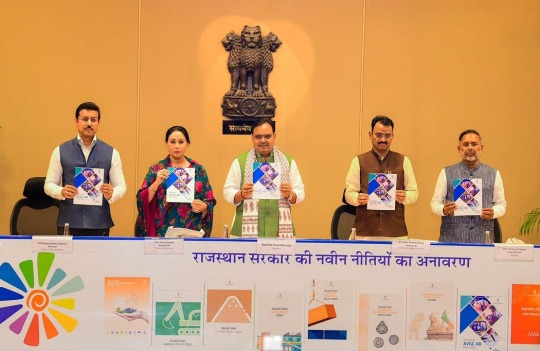
Rajasthan, known for its cultural heritage and historic prominence, is making waves with forward-thinking policies designed to usher in a new era of growth and development. Col Rajyavardhan Rathore, a dynamic leader and advocate of progress, has been instrumental in shaping and supporting these initiatives. These policies aim to address critical areas such as economic development, environmental sustainability, social equity, and digital transformation, marking a significant step forward for the state.
A Vision for Progress
The new policies reflect the Rajasthan government’s commitment to fostering innovation, inclusivity, and sustainability. By targeting various sectors, from education and infrastructure to technology and rural development, these initiatives promise a brighter and more prosperous future for all.
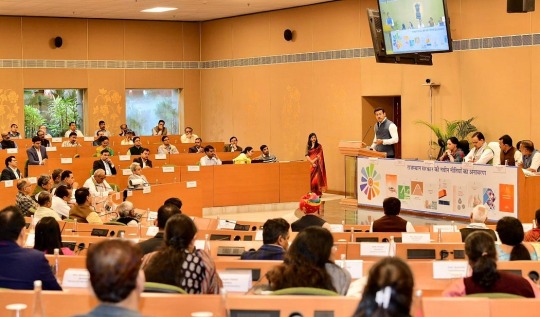
Key Policies Unveiled
1. Rajasthan MSME Policy 2024
Micro, Small, and Medium Enterprises (MSMEs) form the backbone of Rajasthan’s economy. This policy aims to:
Provide financial assistance and subsidies to MSMEs.
Simplify regulatory processes to encourage entrepreneurship.
Create employment opportunities, especially in rural areas.

2. One District, One Product (ODOP) Scheme
To boost local businesses and crafts, the ODOP scheme promotes:
Identifying unique products in each district for focused development.
Establishing market linkages and export support.
Providing branding and marketing assistance to artisans and producers.

3. Rajasthan Startup Policy 2024
The state’s focus on fostering innovation is evident through its startup-friendly policies, which include:
Seed funding and incubation support for startups.
Incentives for women-led and rural-based startups.
Establishing innovation hubs across districts.

4. Integrated Cluster Development Scheme
This policy aims to modernize and empower traditional industries by:
Developing common facilities for industrial clusters.
Providing training programs for workers in emerging technologies.
Enhancing infrastructure to attract investments.

5. Rajasthan AVGC-XR Policy 2024
Focusing on the Animation, Visual Effects, Gaming, and Extended Reality (AVGC-XR) sectors, this policy includes:
Setting up AVGC-XR training institutes.
Providing subsidies for software and hardware procurement.
Promoting Rajasthan as a hub for creative industries.

Environmental Sustainability Policies
6. Rajasthan Green Energy Initiative
To combat climate change and boost renewable energy production, the policy emphasizes:
Developing large-scale solar and wind energy projects.
Offering incentives for businesses to adopt green energy solutions.
Encouraging electric vehicle adoption through subsidies.
7. Water Conservation Policy
Addressing water scarcity in Rajasthan, this policy includes:
Promoting rainwater harvesting and groundwater recharge.
Modernizing irrigation systems to improve efficiency.
Encouraging community-driven water conservation efforts.
Social Development Policies
8. Rajasthan Women Empowerment Scheme
Aimed at promoting gender equality, this policy focuses on:
Providing skill training and entrepreneurship opportunities for women.
Ensuring safety and security through improved law enforcement.
Offering financial incentives for girls’ education.
9. Antyodaya Seva Camp Initiative
Launched to mark the successful completion of the BJP government’s first year, this program:
Provides direct access to government schemes and services.
Ensures welfare benefits reach the most marginalized communities.
Organizes awareness drives about social and economic rights.
Education and Digital Transformation
10. Rajasthan DigiSkill Program
To prepare the workforce for a digital future, this program includes:
Training in digital tools, AI, and coding for youth.
Setting up digital labs in schools and colleges.
Offering certifications in high-demand IT skills.
11. Rajasthan Education Excellence Policy
Focused on improving education quality across the state, the policy entails:
Modernizing school infrastructure and integrating digital tools.
Recruiting highly qualified teachers for rural and underserved areas.
Enhancing vocational training opportunities.
Economic Growth and Investment Policies
12. Rising Rajasthan Global Investment Summit
This annual event highlights the government’s commitment to attracting global investments by:
Showcasing Rajasthan’s potential in IT, manufacturing, and tourism.
Facilitating investor-friendly policies and incentives.
Establishing Special Economic Zones (SEZs) for key industries.
13. Rajasthan Export Promotion Policy
Aimed at boosting exports, this policy provides:
Support for exporters through subsidies and infrastructure.
Promotion of Rajasthan’s traditional handicrafts and textiles globally.
Setting up export training centers for budding entrepreneurs.
Col Rajyavardhan Rathore: A Champion of Progress
Col Rajyavardhan Rathore has been a driving force behind these transformative policies. His efforts include:
Advocating for inclusive and sustainable growth.
Encouraging public-private partnerships to enhance infrastructure and investment.
Ensuring that government initiatives are accessible and impactful at the grassroots level.
Impact of the New Policies
Economic Growth
Increased investments in key sectors like IT, renewable energy, and manufacturing.
Growth in MSMEs and startups, creating job opportunities.
Social Development
Enhanced opportunities for women and marginalized communities.
Improved access to education and healthcare.
Sustainability
Progress in renewable energy adoption and water conservation.
Reduced carbon footprint through green energy initiatives.
The Road Ahead
With these policies, Rajasthan is poised to become a leading state in innovation, sustainability, and social equity. The government’s commitment, supported by leaders like Col Rajyavardhan Rathore, ensures that this vision translates into reality. As the state charts its path forward, it sets a benchmark for holistic and inclusive development in India.
2 notes
·
View notes